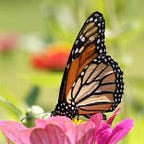Celebrating 60 Years of Silent Spring!
“Those who contemplate the beauty of the earth find reserves of strength that will endure as long as life lasts.” — Rachel Carson, ‘Silent Spring’
Every season for America’s Wild Read, we select a book to share, make it available via our library, and host a virtual book discussion through Zoom open to both employees and the public. This April, we’re excited to read or re-read Rachel Carson’s Silent Spring, the classic that launched the environmental movement on its 60th anniversary year!
Conservation hero Rachel Carson (1907–1964) was a renowned author and one of the first female biologists to work for the U.S. Fish & Wildlife Service. She became one of the most celebrated and beloved science writers in America, but it is easy to forget how controversial Silent Spring was when it was released despite now being a classic of conservation literature.
Rachel Carson had an unusual talent to communicate science through her writing. Silent Spring opens with a fable of a world imagined that’s been devastated by pesticides: the birds are gone, fish have died, livestock are all sick and the people are as well. It’s eerie, frightening, visual and powerful. Silent Spring shares an alarming message of the harmful and toxic effects of overusing pesticides, specifically DDT. This very powerful pesticide was capable of killing hundreds of different kinds of pests at once. Carson describes how it enters the food chain and accumulates in the bodies of animals, including humans. Common pesticides, or “biocides” as Carson called them, didn’t just kill insects; they continued to remain toxic in the environment and kill non-targeted species.
As a result of her powerful book, DDT came under closer government supervision and was eventually banned. The legacy of Silent Spring is how public sentiment about our impact on the environment evolved and led to increased environmental regulation. More importantly, through Silent Spring, we learn that nature is vulnerable, and we must be careful about what we do because we can damage the natural environment. Carson inspires us to live in harmony with nature, to preserve and learn from the natural systems and its intricacies. Silent Spring’s publication and impact are seen as the beginning of the environmental movement. This bestselling book and its message remains popular today even sixty years after its publication.
FWS employees can email megan_burdi@fws.gov to borrow a print copy as available. Silent Spring can also be found at your local library or book-store, or on the Internet Archive. On Thursday, May 19th from 3–4 PM ET we are hosting a Book Discussion via Zoom open to all. Use this Meeting ID: 160 497 5982 and Passcode: b$Tr9E+6R% to join. There will also be a list of discussion questions posted soon if you’d like to go through those as you read.
Brought to you by the USFWS Library, America’s Wild Read is a virtual book club where we aim to inspire you to connect with the outdoors and nature through literature. We hope you will read along with us as we feature various conservation books every quarter — contemporary, traditional, new, and classic.
